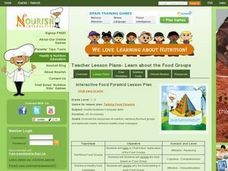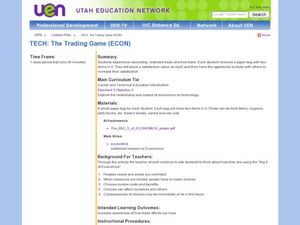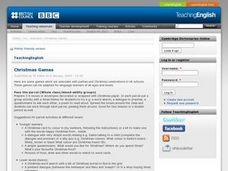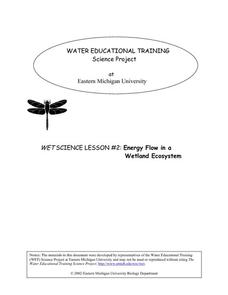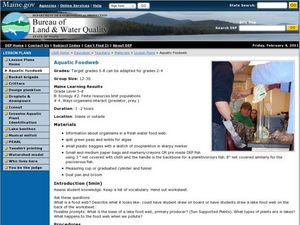Curated OER
Interactive Food Pyramid
Students participate in the game, "Talking Food Pyramid." For this nutrition lesson, students recognize the organization of foods in to five groups. Students conclude by physically classifying a selection of foods in two groups.
Curated OER
Field Trip to the Watsonville Wetlands
Students explore the differences between food webs and food chains. In this wetland lesson students play a food web game and go on a scavenger hunt.
Curated OER
Spill Your Guts
Students practice nutrition facts. In this health and nutrition lesson, students participate in a game in which two teams compete to "spill their guts" by quickly answering factual questions pertaining to nutrition. This lesson is...
Polar Trec
Arctic Smorgasbord!
Two blooms of phytoplankton, instead of just one, now occur in the Arctic due to declining sea ice, which will have widespread effects on the marine life and climate. In small groups, participants build an Arctic food web with given...
Curated OER
TECH: The Trading Game
Property ownership, restricted trade, and free trade are the topics of this game. Kids play a trade game to better understand the interrelationship between technology, economics, and personal choices. Rules to the game and a series of...
Indian Land Tenure Foundation
Sharing Resources: The Nuts Game
The land has always provided its inhabitants with resources that allow them to survive. However, sometimes resources run scarce and sharing becomes an important task. Help little ones understand why and how people have shared resources...
Curated OER
Christmas Games
Your class will practice language and dialog skills by playing games associated with Christmas through these lesson plan ideas. Learners practice English conversation skills while simultaneously acquiring insight into their new culture....
Science Matters
Oh Heron
Two teams—the environmentalists and herons—play four rounds of the game, Oh Heron. Using hand symbols to represent food, shelter, and water, players locate their match to produce more herons while those unmatched decompose.
Curated OER
Food Makes the World Go Round
Fifth graders investigate the origins of foods they eat while they consider social justice issues. In this food sources lesson, 5th graders play a game and then research food distribution, food security, and hunger in the world today....
Curated OER
Marine Ecosystems
Young scholars identify producers and consumers and construct a food chain from four marine ecosystems. They describe the delicate balance among organisms in each environment. In groups, students discuss the human activities that upset...
Curated OER
Mouse Roulette
Students explore the food chain. To gain an understanding about the food web, students participate in a simulation where owlets are being fed by adult owls. Afterward, students examine the results of the role play to determine whether an...
Curated OER
The Riddle of the Playground Cave
Students discuss food groups and combination foods, and solve riddle story.
Curated OER
Traveling Through the Digestive System
Second graders learn about how the food is broken down in our bodies and the job of each body part involved in our digestive system. The utilize the CD ROM game, "Body Works." This wonderful game takes pupils through the human body's...
Eastern Michigan University
Energy Flow in a Wetland Ecosystem
How is energy transferred within an ecosystem? What would happen to a food web if one of the organisms was removed? Elementary or middle school ecologists examine these questions and more in a comprehensive 5E learning cycle lesson....
Science 4 Inquiry
Eukaryotic Cells: The Factories of Life
Eukaryotes include humans, animals, and plants. Scholars learn about the parts of eukaryotic cells. They design models of a store and match the correct function of each part to the function of a part of the cell. They review their...
Curated OER
Pyramid Panic Lesson
Students research human health by identifying fatty and sugary foods. In this food choices lesson, students discuss the five food groups and examine the healthiest choices from each group. Students utilize the web to complete a health...
Curated OER
My Pyramid for Kids
Students become familiar with the proper amounts of different types of foods they should eat each day. In this food pyramid instructional activity, students complete worksheets to develop better eating habits. Students understand the...
Curated OER
Arianna Travels the Orient Express
Fourth graders discuss how they eat when they travel. They resequence a letter that has been separated into pieces. They read the letter aloud, discuss the foods eaten by the writer and analyze whether she ate the right amount of food...
Curated OER
Aquatic Foodweb
Learners explore what a food web is. In this science lesson, students examine how nutrients and other pollutants enter a lake and play a food web game whereby learners pretend they are either zooplankton, planktivore, piscivore, or...
Curated OER
Food and Languages of the World
Students listen to the story "No Blue Food" in this lesson plan. They then discuss Allegra, the main character, and her hesitation to try new foods. They participate in a matching game in which they match cards to determine a fruit...
Curated OER
Bugs in the Woods
Second graders identify insects and plants in the forest ecosystem in a structured field trip with stations and activity booklets. In this bugs instructional activity, 2nd graders explore the ecosystem of the forest, complete the...
Curated OER
Native American Foods
Learners explore Native American foods. In this middle school mathematics lesson, students research the types of foods Native Americans across the country typically ate. Learners summarize a recipe in their own worlds.
Curated OER
Food Descriptions
In this health learning exercise, students look for the right descriptions to describe the food items in the pictures and answer the questions for each one.
National Park Service
Fitting In
Birds help other birds find food? Scholars are placed into one of five groups of different birds. Each group then "feeds" on letters of paper in a field and gather five pieces per person. As each group plays, more food is exposed,...


